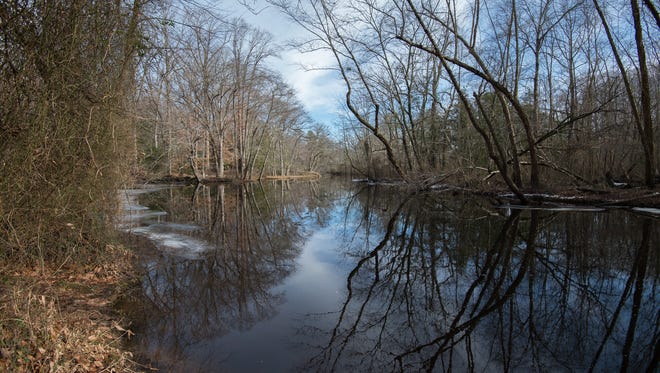Seal swims miles, crosses road in Delaware
A wayward harbor seal swam south from New England into Delaware Bay at Lewes and then headed north to Bowers Beach, where she swam into the Murderkill River and navigated miles of switchbacks, twists and turns to end up near the spillway at Coursey Pond.

No one is certain how long it took her to make the trip, but in recent days, when the ground was snow-covered, she took her adventure farther. A local resident watched the seal haul out, amble up an access road and then venture across Del. 15 at Carpenters Bridge. She slipped back into the water at Coursey Pond. The pond dam and spillway would have blocked a more direct route.

If she keeps going, she could end up near Killens Pond at Felton. The headwaters of the Murderkill are 21 miles from Delaware Bay.
Considering that she traveled south from New England, "it's not that far for a seal," said Suzanne Thurman, executive director of the Marine Education, Research & Rehabilitation Institute, based in Lewes. "What's 12 miles or so up a creek?"
Thurman said in the past, there have been other seal sightings on tributaries of the Delaware Bay, including the Mispillion, at Little Creek and Leipsic and along the St. Jones just southeast of Dover.
The thing that makes this sighting so interesting is that the seal has shown up in a populated area where people can see it, she said.
MERR volunteers have been at the creek leading up to the pond for a couple of weeks just to make sure that people understand that seals, while cute from a distance, are wild animals and can be dangerous.
Jim Cox, of Milford, said he was fishing just east of the spillway just after Christmas.
"A wave came up," he said. "Where did that come from?" he recalled asking himself. "Then she came up and laid on the cement."
Thurman said the seal is an adult female and she weighs between 150 and 200 pounds. She appears healthy, Thurman said.
That means that at this point, MERR staff and volunteers are simply keeping an eye on her. Any rescue effort would stress the seal, she said.

Jason Davis, an environmental scientist with the state Department of Natural Resources and Environmental Control, said the seal is likely finding plenty to eat.
Typically, he said, they favor fish that are small enough to swallow whole. The bass and bluegills in the pond and creek would be the perfect size, he said.

In the Atlantic, harbor seals are found from the eastern Canadian Arctic and Greenland south to southern New England and New York. Sometimes they migrate as far south as the Outer Banks of North Carolina.
Federal fisheries scientists estimate the population at just under 76,000 in the region.
Seal sightings used to be rare along the Delaware coast. They were among seal species that were hunted for the fur trade. Since the passage of the Marine Mammal Protection Act in 1972, the northern population has rebounded, and harbor seals have moved farther south in the winter to find food.
Typically, Thurman said, February is the big month for seal reports in Delaware waters. The animals start showing up around Thanksgiving and are regularly spotted on the breakwaters off Lewes and at Indian River Inlet, she said. The rock jetties give the animals a place to haul out and rest, she said. Some seals haul out on the beaches, too, she said.
STORY: Four years, zero emails written by Wilmington mayor
STORY: Former Sen. Blevins new state animal welfare director
If people see seals on the beach or other unexpected areas, they should contact MERR at (302) 228-5029. They shouldn't approach a seal as the animals can become aggressive and can bite.
In the case of the Coursey Pond seal, people should watch from a distance.

Meanwhile, Thurman said, there haven't been any sightings of the seal in recent days so if area residents to see her, Thurman would like to hear about it.
That the seal crossed the road to get to the pond side is both amazing and a bit of a concern because of the high-speed traffic on the two-lane road, she said.
"She may be in the big pond, or she could have crossed back over," she said. "The members of the community have taken on this caregiver's role."
With ample food and enough space away from people, Thurman said, "there is absolutely no reason for her to want to leave."
Contact Molly Murray at (302) 463-3334 or mmurray@delawareonline.com. Follow her on Twitter @MollyMurraytnj.
HARBOR SEAL FACTS
Weight: up to 245 pounds
Length: 6 feet
Appearance: blue-gray back with light and dark speckling; males are usually larger
Lifespan: 25-30 years
Diet: fish, shellfish, crustaceans
Behavior: They haul out on land or rocks and rest with head and flippers elevated
Harbor seals are part of the "true seal" family, Phocidae. True seals lack external ear flaps and have short forelimbs that result in limited locomotion on land.
Source: NOAA Fisheries